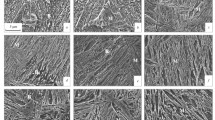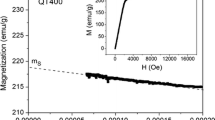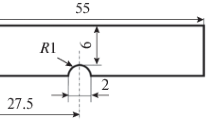Conclusions
-
1.
To obtain a martensitic structure with quenching in oil (cooling rate 20–30 deg/sec) for steel containing 0.3% C and 4% Co the nickel content should be at least 9%.
-
2.
With increasing nickel concentrations from 5 to 9% in the thermally hardened steel containing ∼0.3% C and ∼4% Co the standard mechanical properties change little (σb, σ0.2, δ5, θ), and there is no change in the work of crack propagationa p. The principal effect of nickel in these steels, as in other structural steels, is an increase of resistance to brittle fracture, manifest in a lower ductile-brittle temperature.
-
3.
The addition of cobalt to the steel with ∼0.3% C and 9% Ni increases the strength with no substantial reduction of the ductility or toughness, and with a substantial drop of the ductile-brittle temperature. This effect is evident with a change of the cobalt content from 0 to 4%; a larger amount of cobalt has a negative effect on the ductility.
Similar content being viewed by others
LIterature cited
V. N. Zikeev, Modern structural steels for machine construction,” Metal. i Term. Obrabotka Metal., 4, 5–8 (1972).
A. P. Gulyaev and V. P. Emelina, “Effect of alloying elements on properties of ferrite,” Stal', 12, 139–143 (1947).
V. M. Doronin, “Effect of elements on mechanical properties of alloyed ferrite,” Stal' 4, 349–353 (1952).
A. A. Spektor, V. I. Sarrak, and R. I. Éntin, “Reasons for the effect of nickel on cold brittleness of iron,” Dokl. Akad. Nauk SSSR,155, 5, 1054–1057 (1964).
Ya. E. Gol'dshtein and G. A. Charushnikova, “Effect of nickel on cold brittleness of steel,” Metal. i Term. Obrabotka Metal., 12, 12–15 (1962).
E. K. Novikova, A. P. Gulyaev, and O. N. Meshcherinova, “Effect of nickel on ductile characteristics of structural steels,” Metal. i Term. Obrabotka Metal., 9, 46–52 (1967).
A. P. Gulyaev and A. M. Fatkina, “Effect of nickel on mechanical properties and ductile-brittle transition temperature of low-carbon steel,” Metal. i Term. Obrabotka Metal., 10, 34–39 (1966).
M. M. Shteinberg, in: Heat Treatment of Metals [in Russian], Mashgiz, Moscow (1952).
V. Drege, Steel as a Structural Material [in Russian], Metallurgiya, Moscow (1967).
Yu. A. Shul'te, Cold Resistant Steels [in Russian], Metallurgiya, Moscow (1970), pp. 28–29.
K. Irvin, J. Iron Steel Inst.,200, 10, 202 (1962).
J. Pascover and S. Matas, ASTM Special Technical Publication No. 370 (1965), pp. 30–44.
D. Coutsouradis et al., Cobalt, 37, 192–202 (1967).
M. Trusculescu, Studii si Cercetări de Metalurgie, Acad. R.S.R.,11, 2, 221–242 (1966).
M. Trusculescu, Cercetărie Metalurg., Bucuresti, 9, 331–342 (1967).
E. Houdremont, Cobalt Steels, in: Special Steels [Russian translation], Vol. 2, Metallurgiya, Moscow (1966), pp. 1194–1249.
V. I. Sarrak and N. A. Shilov, “Effect of cobalt on susceptibility of iron to brittle fracture,” Fiz. Metal. Metalloved.,22, 4, 606–610 (1966).
A. P. Gulyaev, “Separation of impact toughness into its component parts by means of test data for samples with different notches,” Zavod. Lab.,33, 4, 473–475 (1964).
B. A. Drozdovskii and Ya. B. Fridman, Effect of Cracks on Mechanical Properties of Structural Steels [in Russian], Metallurgizdat, Moscow (1960).
A. P. Gulyaev, V. D. Zelenova, and I. V. Shermazan, “Determining the ductile-brittle transition temperature by electron fractographic analysis,” Zavod. Lab., 7, 870–872 (1966).
Additional information
Central Scientific-Research Institute of Ferrous Metallurgy. Translated from Metallovedenie i Termicheskaya Obrabotka Metallov, No. 2, pp. 2–8, February, 1975.
Rights and permissions
About this article
Cite this article
Gulyaev, A.P., Zikeev, V.N. & Guseinov, R.K. Effect of nickel and cobalt on the properties of medium-carbon high-strength steel. Met Sci Heat Treat 17, 95–103 (1975). https://doi.org/10.1007/BF00679157
Issue Date:
DOI: https://doi.org/10.1007/BF00679157




